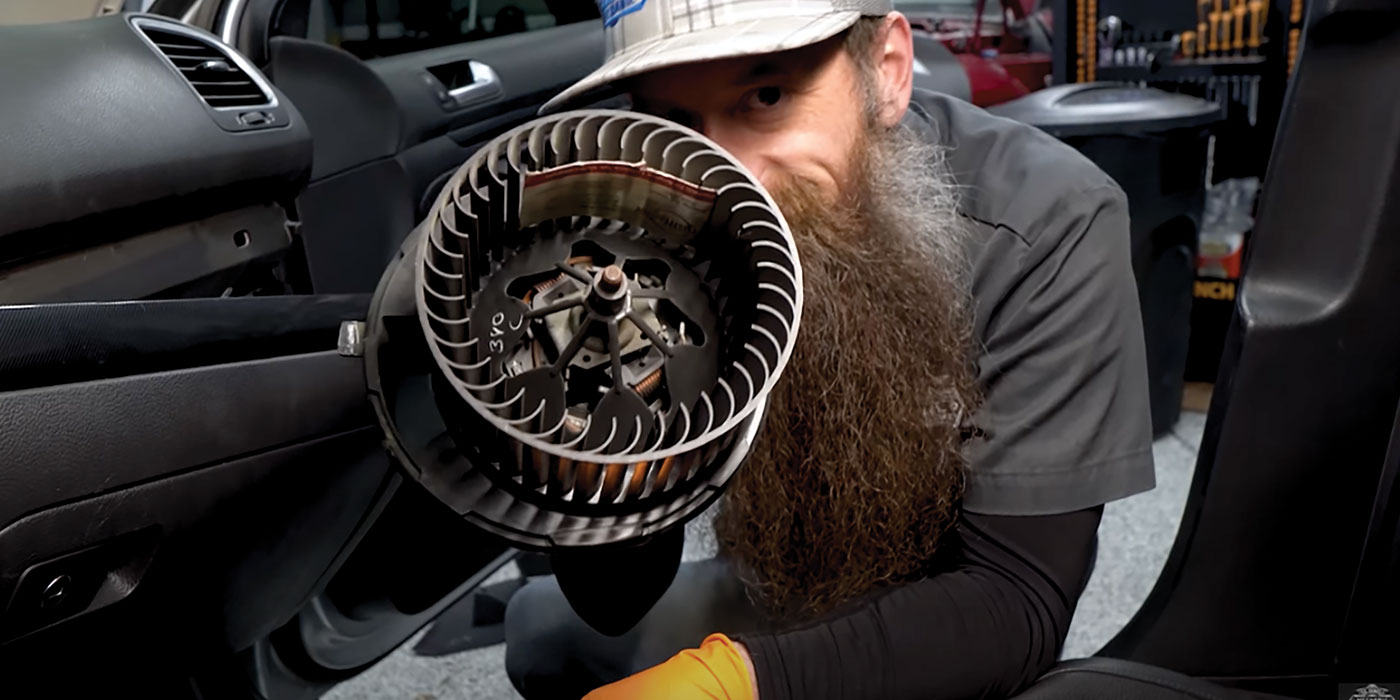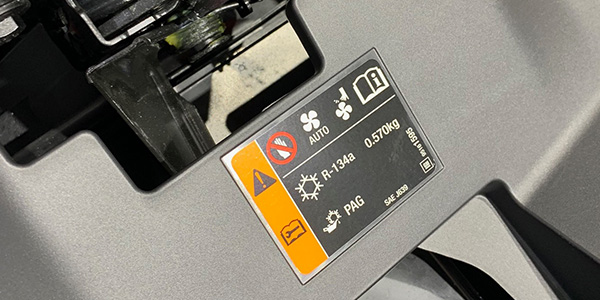Chrysler’s 24-valve 3.5L single overhead cam V6 engine was introduced back in 1993 in their LH platform cars (Chrysler Concorde, Dodge Intrepid and Eagle Vision). Since then it has been used in a variety of Chrysler models.
The 3.5L engine is an even-firing power plant with aluminum cylinder heads, a single camshaft in each cylinder head and four valves per cylinder. It has a sequential fuel injection system with distributorless ignition. The engine is rated from 214 to 220 horsepower depending on the model year, and delivers good torque from 2,000 to 5,600 rpm.
Engine Block
The 3.5L block is cast iron and shares the same bore centers and stroke with the older 3.3L pushrod engine, but the bores are larger. The 3.5L displaces 3518 cc’s with a bore and stroke of 3.78” (96 mm) by 3.19” (81 mm). The front of the 3.5L block is different from the 3.3L so it can accommodate a different oil pump, water pump and the overhead cam timing belt drive and cover. The water pump bypass is internal to the block.
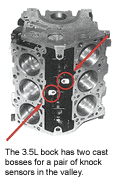 The die cast aluminum oil pump is driven off the nose of the crankshaft, and should deliver a minimum of 25 psi at 3,000 rpm with a relief valve setting of 60 to 70 psi.
The die cast aluminum oil pump is driven off the nose of the crankshaft, and should deliver a minimum of 25 psi at 3,000 rpm with a relief valve setting of 60 to 70 psi.
The timing cover is a multipiece assembly that provides easy access for belt replacement. A camshaft position sensor for the distributorless ignition system is mounted in the timing cover and reads a ring attached to the back of the left camshaft sprocket. The water pump and oil pump housings are integral with the cover. An automatic tensioner is included for the OHC timing belt, which also drives the water pump.
The oil pan on the 3.5L is made of “Antiphon” steel, which consists of a layer of rubber sandwiched between two layers of steel. This deadens sound transmission and helps reduce noise. Fill capacity is 5 quarts when changing the oil.
The block has four main bearings with bore IDs of 68 mm. The main bearing caps are made of nodular iron, and main bearings #2 and #3 are cross-bolted like the old 426 hemi for added strength. Chrysler says when the caps are installed, the vertical bolts should be tightened first, then the side bolts. The OE main bearing clearances are 0.011 mm to 0.072 mm, with rod bearing clearances of 0.035 mm to 0.055 mm.
The crankshaft is forged steel (MS-9178 alloy) with 64 mm main journals and 58 mm rod journals. Chrysler says maximum out of round for the main journals should not exceed 0.003 mm, maximum taper 0.003 mm and maximum hourglass 0.002 mm. The specified crankshaft end play is 0.11 to 0.31 mm.
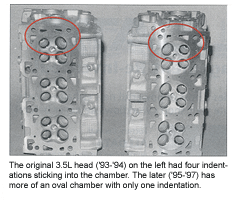 The engine is even-firing, with a firing order of 1-2-3-4-5-6. Cylinder #1 is at the right front, with #1, #3 and #5 on the right bank and #2, #4 and #6 on the left bank.
The engine is even-firing, with a firing order of 1-2-3-4-5-6. Cylinder #1 is at the right front, with #1, #3 and #5 on the right bank and #2, #4 and #6 on the left bank.
The pistons are cast aluminum with full floating wrist pins, ductile iron compression rings, and are relived so the engine will freewheel without valve interference if the timing belt breaks.
OHC Heads
The heads are cast aluminum with single overhead cams, and four valves per cylinder. The combustion chamber volume is 52 cc’s. One nice feature about these heads is that they can be pulled without having to disassemble any of the valvetrain components. The rocker arms and shafts can also be removed as an assembly. Chrysler says the heads can accommodate up to 0.008” of resurfacing. Compressed head gasket thickness is 1.78 mm plus or minus 0.05 mm. Torque-to-yield head bolts are used, and should be replaced if you are changing a head gasket. The head bolts should first be torqued to 45 ft.-lbs., then 65 ft.-lbs. and then given an additional 90° turn.
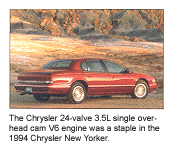 The spark plugs (RCL12LYC) are centered in the combustion chambers and set deep in the heads. Access is through tubes in the valve cover. The tubes should not be reused, says Chrysler, if the valve covers are removed. The valve covers are also Antiphon steel and use steel reinforced molded rubber gaskets.
The spark plugs (RCL12LYC) are centered in the combustion chambers and set deep in the heads. Access is through tubes in the valve cover. The tubes should not be reused, says Chrysler, if the valve covers are removed. The valve covers are also Antiphon steel and use steel reinforced molded rubber gaskets.
The intake valves have flash chrome-plated stems with stem diameters of 6.935 mm to 6.953 mm. The stems on the exhaust valves are chrome plated and measure 6.906 mm to 6.924 mm. Three bead stem locks are used on both. Seats on both the intakes and exhausts are 44.5° to 45°, with valve face angles of 45° to 45.5°. Intake valve diameter measures 35 mm while exhausts are 29 mm.
The valves guides are replaceable and are pressed in with an interference fit. They also have positive seals that are integral with the spring seats. The inside diameter for both the intake and exhaust guides measures 6.975 mm to 7.000 mm.
The intake and exhaust valves use different springs, which are color coded and wound differently so you can tell them apart. The stiffer intake springs are color coded with white paint and are wound clockwise, while the exhausts are color coded pink and are wound counterclockwise.
Each head has two rocker shafts that support four rocker arms per cylinder. One intake rocker has a lift ratio of 1.39 while the second has a ratio of 1.98. The exhaust ratios are 1.38 and 1.83 respectively. Each rocker arm also has a 12 mm mini-hydraulic lash adjuster in the valve end with a swivel foot that contacts the tip of the valve stem. The adjusters are held in place by snap rings and are not removable. Chrysler says the rocker arms should be soaked in oil before they’re installed because the adjusters may clatter up to an hour if they’re installed dry.
Searching ALLDATA, we found a Chrysler technical service bulletin (09-01-96) describing a hydraulic lash adjuster noise problem with this engine. A heavy clicking or ticking noise coming from the top of the engine that changes with rpm may occur due to oil aeration if the crankcase is overfilled with oil. If the noise persists after correcting the oil level, it may indicate valvetrain damage.
After pulling the valve covers, check the underside of the intake rockers for signs of contact with the camshaft. If there is no sign of contact, any rocker arms that have a soft or spongy lash adjuster should be replaced. Lash adjusters should not compress easily. Use new rocker arm pedestal dowels and camshaft sprocket screws when reassembling the valvetrain components.
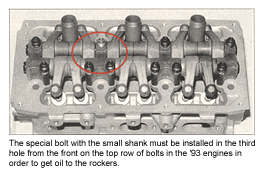 If you have to replace a camshaft, the labor on this job is nine hours for just one side! The cams themselves are hardened nodular iron. Left and right cams are different (the left one is longer) so they can’t be interchanged, and the cams are installed into the heads from the rear so they can’t be changed without removing the engine from the car. Journal bearing diameters are 42.939 mm to 42.960 mm. The cams are held in place by thrust plates at the back of each head.
If you have to replace a camshaft, the labor on this job is nine hours for just one side! The cams themselves are hardened nodular iron. Left and right cams are different (the left one is longer) so they can’t be interchanged, and the cams are installed into the heads from the rear so they can’t be changed without removing the engine from the car. Journal bearing diameters are 42.939 mm to 42.960 mm. The cams are held in place by thrust plates at the back of each head.
The cam bolts that hold the drive sprockets are unusually long, threading into deep holes in the front of each cam. Chrysler says this compresses the end of the cam when the bolts are tightened to improve strength. This is probably necessary because the left cam sprocket sticks out quite a distance from the head. The cam bolts are the torque-to-yield variety (40 ft.-lbs., plus a 90° twist), but Chrysler says they can be reused provided locking compound is applied to the threads.
The belt-driven cam sprockets have “D” flats for “rough” alignment but no keyways – which means a special alignment procedure is required when the cams are installed or the timing belt is replaced to achieve correct valve timing. The procedure involves removing the cam covers on the back of the heads and fitting a special tool on the head that holds the cam in the proper position. The cam bolt that holds the sprocket is then tightened to lock the sprocket in the proper position. Chrysler says this technique assures better cam timing because it eliminates the problem of tolerances stacking up.
Active Tuned Intake Manifold
The 3.5L has what Chrysler calls an “active” tuned intake manifold. It’s an aluminum cross ram design with dual 48 mm throttle bodies, a separate plenum for each bank of cylinders and individual runners for each port. This configuration boosts both low and high speed torque as much as 15 lb.-ft. compared to a conventional manifold.
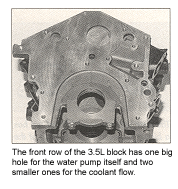 A special computer-controlled “Manifold Tuning Valve” (MTV) is located on a passageway between the split-plenums to adjust the plenum volume according to engine load and rpm. The MTV valve helps broaden the engine’s torque curve.
A special computer-controlled “Manifold Tuning Valve” (MTV) is located on a passageway between the split-plenums to adjust the plenum volume according to engine load and rpm. The MTV valve helps broaden the engine’s torque curve.
The thermostat housing is located in the front of the lower intake manifold. The manifold has two ports for EGR (one for each side) and a screw-in PCV valve. The PCV valve has a very low flow rate because the engine produces only about one cfm of blowby up to 5,200 rpm when the engine is new, says Chrysler. But in an older high mileage engine, blowby may be more than the original PCV valve can handle. This may lead to oil sludging if the oil is not changed often enough.
The top half of the manifold can be removed to gain access to the fuel injectors, which are mounted on a plastic fuel rail assembly that plugs into the lower intake manifold.
Chrysler issued a safety recall (No. 790) in January 1999 on the fuel rail assembly because of a leakage problem with the fuel rail’s O-rings. In addition, the passenger side fuel rail could also crack and leak fuel creating a severe fire hazard. The recall fix is to replace the fuel rail O-rings and to reinforce the passenger side fuel rail if it is not cracked. If the rail is cracked, it must be replaced with a new one from Chrysler.
Service Precautions
A couple of cautions must be kept in mind when working on this engine. One is the engine can be accidentally started if cranked with the ignition on when the top half of the manifold or either throttle body has been removed. That’s because the injectors are located on the lower half of the intake manifold and can still feed fuel to the cylinders. Without any throttling, the engine can suddenly rev to redline with nasty consequences. So always disable the ignition before doing a cranking compression test if the top of the manifold or a throttle body has been removed.
The other caution applies to the injectors. They’re the bottom feed variety, which means fuel can drain from the fuel rail into a cylinder and hydrolock the engine if an injector is removed. So prior to removing an injector, the fuel rail should be disconnected and blown out or drained. If fuel gets into a cylinder, remove the spark plug, disable the ignition and crank the engine to force the fuel out the spark plug hole.
Oxygen Sensor Problem
On some 1995-’96 LH cars, the Malfunction Indicator Lamp may come on, and be accompanied by a possible sag or hesitation or rough idle problem. When you hook up a scan tool, you may find codes that indicate the right or left upstream O2 sensor is shorted to voltage. The cure here is not to replace the sensors, says Chrysler technical service bulletin 08-13-99, but to install a special jumper wire harness to correct the broken splice in the wiring harness. Ignition
The 3.5L has a distributorless ignition system (DIS), with the coil module mounted on the intake manifold. Twin knock sensors (one for each cylinder bank) are used to control detonation. The sensors are located under the intake manifold, so access requires pulling the manifold. That’s why Chrysler uses two sensors. If one fails, the other takes over.
If a 3.5L engine is having a cold start problem, TSB 18-15-95 describes a possible fix: the original factory spark plugs may have too cold a heat range and be fouled. Chrysler recommends replacing the plugs with new Champion RC12LYC plugs gapped to 0.035”, and reflashing the PCM with new software that changes the cold start fuel mixture. This only applies to engines built between Oct. 24, 1994 and Feb. 17, 1995.
|
The 3.5L V6 included a number of “firsts” for Chrysler when it was introduced over a decade ago
:
A water pump with a molded plastic impeller, the first of its kind used by any domestic vehicle manufacturer. The scroll-shaped impeller uses 3 to 4 less horsepower than a stamped-steel impeller. It’s also rustproof, quieter and provides better balance. But there have been instances where debris in the cooling system has caused accelerated erosion and wear of the impeller, causing the engine to overheat because of reduced coolant flow. Replacement water pumps should have the same design as the original to maintain the same cooling characteristics, says Chrysler. A compression ratio 10.4 to 1, the highest of any standard Chrysler production engine since the 1970s. Yet it can run on mid-grade (89 octane) unleaded fuel thanks to dual knock sensors. A six-piece crankshaft thrust bearing with separate side sections that provide better alignment with the block and reduce wear. A north-south orientation in the engine bay instead of the more common east-west transverse configuration for a domestic FWD car. A “returnless” electronic fuel injection system that has no return line from the fuel rail back to the fuel tank. The pressure regulator for the “Sequential Multi Point Injection” (SMPI) system is located in the gas tank with the electric fuel pump. The design eliminates some plumbing and also keeps the fuel cooler because it doesn’t circulate back and forth between the engine and fuel tank. It’s the same SMPI fuel system that is also used on Chrysler’s 5.9L Magnum and 5.2L truck engines, the 3.0L SOHC, 3.3L and 3.8L passenger car V6s, and the 2.5L, 2.4L 2.2L and 1.8L engines from ’93 forward. Lightweight connecting rods that lack the usual balance pads. Balance is achieved by select-matching the rods with the pistons (an important point to remember if you ever have to replace a rod. Torque on the cap bolts is 40 ft.-lbs. plus an additional 90° twist. |
| For more information on the Chrysler 3.5L and the other 60° V6 engine family members, read “Rebuilding the Chrysler V6 Engine Family,” by Doug Anderson. You can retrieve and print a copy of Anderson’s article by visiting www.underhoodservice.com and clicking on the Search Back Issues link. From there, type in the key word Chapman into the “Search For” box. Next, open the Search Index link and click on Engine Builder magazine. Scroll down the list of entries until you see the Anderson article. |





